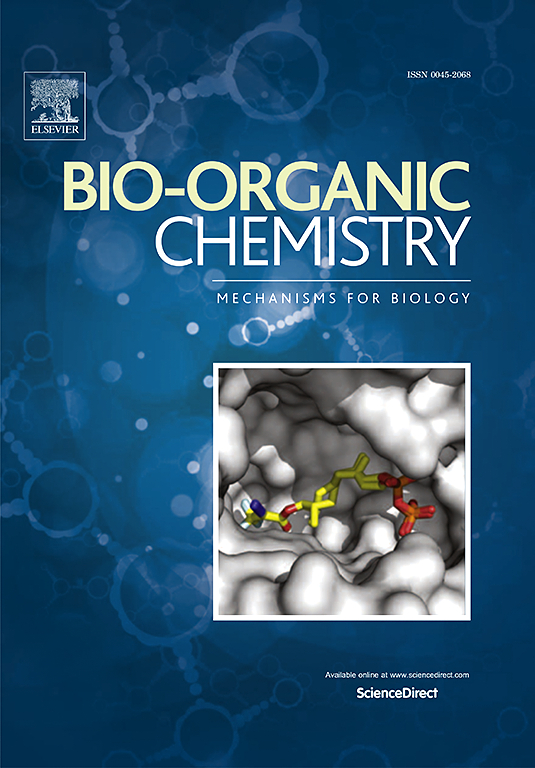含有DAAP片段的新型ALK抑制剂:合理的药物设计和抗肿瘤活性研究
IF 4.5
2区 医学
Q1 BIOCHEMISTRY & MOLECULAR BIOLOGY
引用次数: 0
摘要
间变性淋巴瘤激酶(ALK)是一种受体酪氨酸激酶,属于胰岛素受体亚家族,参与胰岛素相关的细胞信号通路。ALK基因在正常人体组织中不活跃,但在中枢神经系统中表现出高表达。然而,ALK基因的失调与非小细胞肺癌(NSCLC)的发展有关。尽管市售ALK抑制剂对大多数ceritinib耐药突变体表现出良好的临床疗效,但它们对G1202R突变体表现出耐药性。因此,开发新的ALK抑制剂对于解决患者的耐药问题至关重要。设计合成了48种新型2,4-二芳基嘧啶类ALK抑制剂,并对其抗肿瘤活性进行了研究。其中,Ld-10对ALK激酶表现出明显的抑制活性,IC50值为1135 nM;对肺癌细胞H2228表现出良好的抗增殖活性,IC50值为1.35±0.13 μM。为了进一步验证Ld-10的抗肿瘤潜能,我们进行了一系列体外药理实验。其中包括溶血试验,以确认其低毒性,AO试验,JC-1染色试验和Calcein-AM/PI细胞双染色试验,以评估细胞凋亡诱导。此外,我们在G0/G1期进行剂量依赖性阻滞以评估细胞生长抑制作用,并进行细胞周期分析和克隆实验,为化合物Ld-10显著抑制肿瘤生长提供证据。体内药理学实验表明,Ld-10有效抑制肿瘤生长,对小鼠器官无明显毒性作用。基于我们实验研究的这些综合发现,可以得出结论,Ld-10作为一种新的ALK抑制剂具有很大的潜力。本文章由计算机程序翻译,如有差异,请以英文原文为准。

Novel ALK inhibitors containing DAAP fragments: Rational drug design and anti-tumor activity research
Anaplastic lymphoma kinase (ALK) is a receptor tyrosine kinase belonging to the insulin receptor subfamily, involved in cellular signaling pathways associated with insulin. While ALK gene remains inactive in normal human tissues, it exhibits high expression specifically in the central nervous system. However, dysregulation of the ALK gene has been implicated in non-small cell lung cancer (NSCLC) development. Although commercially available ALK inhibitors demonstrate favorable clinical efficacy against most Ceritinib-resistant mutants, they exhibit resistance towards G1202R mutants. Therefore, developing novel ALK inhibitors is crucial for addressing drug resistance in patients. We designed and synthesized 48 novel 2,4-diarylpyrimidine-based ALK inhibitors and investigated their antitumor activities. Among them, Ld-10 showed significant inhibitory activity against ALK kinase with an IC50 value of 1135 nM and demonstrated excellent antiproliferative activity against lung cancer cells H2228 with an IC50 value of 1.35 ± 0.13 μM. To further validate the antitumor potential of Ld-10, we conducted a series of in vitro pharmacological experiments. These included a hemolysis assay to confirm its low toxicity profile, an AO assay, a JC-1 staining assay, and a Calcein-AM/PI cell double staining assay for assessing apoptosis induction. Additionally, we performed dose-dependent arrest at G0/G1 phase to evaluate inhibition of cell growth and carried out cell cycle analysis and cloning experiments to provide evidence for significant tumor growth inhibition by compound Ld-10. In vivo pharmacological experiments demonstrated effective tumor growth inhibition without any significant toxic effects on mouse organs caused by Ld-10 administration. Based on these comprehensive findings from our experimental investigations, it can be concluded that Ld-10 holds promising potential as a novel ALK inhibitor.
求助全文
通过发布文献求助,成功后即可免费获取论文全文。
去求助
来源期刊

Bioorganic Chemistry
生物-生化与分子生物学
CiteScore
9.70
自引率
3.90%
发文量
679
审稿时长
31 days
期刊介绍:
Bioorganic Chemistry publishes research that addresses biological questions at the molecular level, using organic chemistry and principles of physical organic chemistry. The scope of the journal covers a range of topics at the organic chemistry-biology interface, including: enzyme catalysis, biotransformation and enzyme inhibition; nucleic acids chemistry; medicinal chemistry; natural product chemistry, natural product synthesis and natural product biosynthesis; antimicrobial agents; lipid and peptide chemistry; biophysical chemistry; biological probes; bio-orthogonal chemistry and biomimetic chemistry.
For manuscripts dealing with synthetic bioactive compounds, the Journal requires that the molecular target of the compounds described must be known, and must be demonstrated experimentally in the manuscript. For studies involving natural products, if the molecular target is unknown, some data beyond simple cell-based toxicity studies to provide insight into the mechanism of action is required. Studies supported by molecular docking are welcome, but must be supported by experimental data. The Journal does not consider manuscripts that are purely theoretical or computational in nature.
The Journal publishes regular articles, short communications and reviews. Reviews are normally invited by Editors or Editorial Board members. Authors of unsolicited reviews should first contact an Editor or Editorial Board member to determine whether the proposed article is within the scope of the Journal.
 求助内容:
求助内容: 应助结果提醒方式:
应助结果提醒方式:


